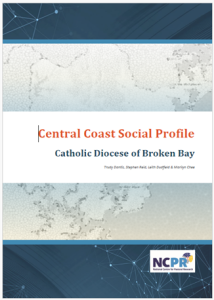In 2021, the Diocese of Broken Bay commissioned the NCPR to undertake a project providing an extended social profile for the region of their diocese known as the Central Coast. This project utilised data from a number of sources including:
- Australian Bureau of Statistics (ABS)
- CatholicCare
- Catholic Schools Broken Bay (CSBB)
- Catholic Schools NSW
- Central Coast Local Health District (CCLHD)
- Education Services Australia
- NCLS Research
- NSW Central Coast Aboriginal Community (Darkinjung Country)
- NSW Government
- The Diocese of Broken Bay
- Mass attendance data from the Australian Catholic Bishops Conference National Count of Attendance 2001, 2006, 2011, 2016 and 2021.
The extended profile was presented in five sections, which provided more depth on each of the subject areas.
- The first section provided an overview of the region and highlighted some key demographics of the population along with the distinctive features of the community.
- The second section provided an in-depth exploration of the Catholic population using predominantly Census data. It also included key information on the socio-economic status of the area.
- The third section focused on Catholic parishes and the demographics of the Mass-attending community. There were also important insights from the findings of the National Church Life Survey.
- The fourth section looked at Catholic schools in greater detail through several key areas such as enrolments, school fees and the demographic profile of students in primary and secondary schools in the Central Coast. This section also included forecast student numbers for future planning and counselling and wellbeing data.
- The fifth section explored the health services available in the Central Coast. It discussed the clinical services plan provided for the region and highlighted a number of important insights drawn from CatholicCare and the range of services they provide.
The information provided in the report may be used to inform pastoral ministry in the area, to support the vitality of parishes in the region and identify significant areas for other ministries.
Report details: May 2022. Trudy Dantis, Stephen Reid, Leith Dudfield & Marilyn Chee, Central Coast Social Profile: Catholic Diocese of Broken Bay. Australian Catholic Bishops Conference.
